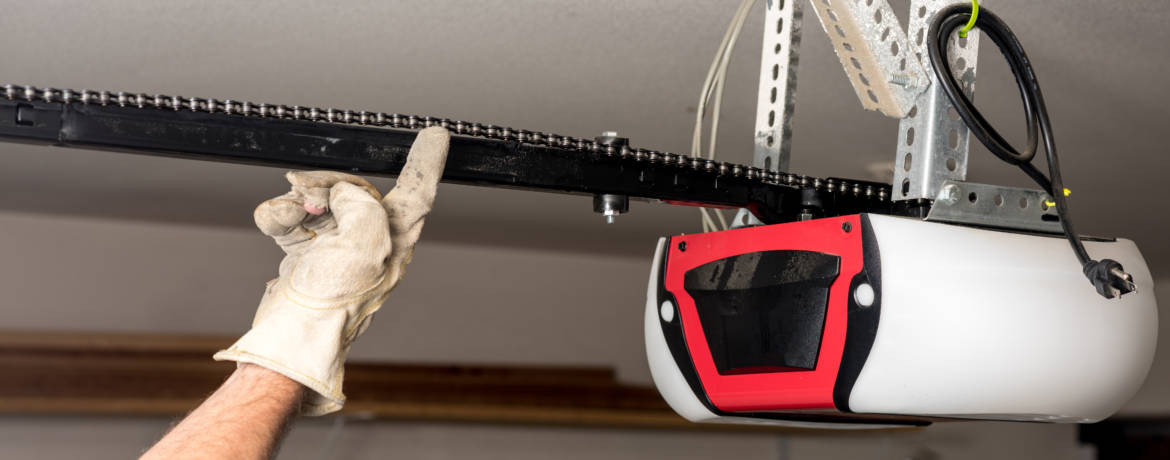What to Do if Your Garage Door Won’t Open

Your garage door opener is a great convenience you probably use almost every day but likely take for granted. In fact, the average garage door in the U.S. opens and closes 1,500 times per year. But what happens when your garage door opener doesn’t work?
Garage door openers have an average lifespan of 10 to 15 years, maybe longer if you have maintained them well. But sometimes, something goes wrong and your garage door doesn’t open, or your garage door gets stuck open, or it behaves in some other erratic way.
Below, you will find some of the most frequent causes for why garage door openers fail, as well as what you may be able to do about them. Some have quick or simple fixes you can do yourself, while others will likely require the help of a certified professional. Still, being able to identify the problem can help keep you safe, and your garage door from sustaining further damage.
PLEASE TAKE CAUTION: Any time you attempt to do any work or repairs on your garage door, you should always turn off the power to your garage door opener. It should go without saying that you don’t want the door accidentally activated while you’re working, nor, as with any DIY home project, do you want to encounter electricity. If it is safe to do so, try to work with the door closed.
How does a Garage Door Opener Work?
Depending on the drive type– chain, belt, or screw (discussed below)- a trolley attached to the garage door by a J-arm is pushed or pulled by the chain, belt, or screw along a track by the motor, sometimes referred to as the operator. This activates the opening and closing of the door. But the real heavy work is done by the springs attached to the garage door. These can either be extension springs which run along the sides of the door, or torsion springs which run above the door.
Why Won’t My Garage Door Open?
1. Remote Control Issues. This is one of the most common reasons your garage door doesn’t open when you signal it to. It isn’t always just a simple matter of changing the batteries in the remote or checking that you haven’t accidentally locked the remote – although often this is the case. If you have checked these simple fixes first, make sure the antenna on the motor is hanging down and isn’t blocked by anything, including dirt, and isn’t damaged or broken. If none of these are the problem, try resetting your remote according to your owner’s manual instructions. If you are still unable to open your garage door with your remote but the wall-mounted keypad does open the door, something may be interfering with the signal between your remote and garage door opener. If so, you will likely need the help of a certified technician to identify and bypass the problem.
2. Garage Door Opener Not Getting Power. Check to make sure the opener is plugged in all the way and that the outlet itself is getting power. If the plug is secure and the outlet is powered, you may have a tripped circuit breaker, GFCI (Ground Fault Circuit Interrupter), or blown a fuse. If this is the case, you can either reset the circuit breaker or GFCI, or change the fuse. If you do not feel comfortable doing any of these things, or if they are happening repeatedly, you should consult a certified electrician to examine the problem, which may or may not be with your garage door opener.
3. Broken Torsion or Extension Springs. This is the most common repair problem professionals see. Torsion springs run along the top of the garage door, while extension springs run on either side of the door. You will either have one or the other. Both springs are rated for a certain number of open and close cycles (e.g., torsion springs are generally rated for 10,000 cycles), so these springs do have a limited lifespan. Once they reach the end of their cycle, they can break. The sound of a spring breaking is very loud and sharp. If your door is down when the spring breaks, it will be too heavy for the garage door opener to lift. You should never try to lift it yourself. Without intact springs, that very heavy door could suddenly fall and smash into the floor. If the spring breaks when the door is opened, the garage door could be stuck open. If this happens, don’t try to close the door either. In both cases, call a certified professional immediately. THIS IS NOT A DIY PROJECT. Springs are very dangerous to work with and can cause serious injury or even death if not handled properly.
4. Ruptured Cables. When a spring breaks, quite often the cables associated with that spring will also break. This is a very dangerous situation as the cables can cause grave injuries when they snap. If your spring(s) have broken or become damaged, have a professional check the cables as well. Even if you have the springs replaced, if the cables go, there’s nothing left to lift the door.
5. Motor Has Been Disengaged. If the garage door opener’s motor has been disengaged, the motor will run but the door won’t open. Garage door openers come with a disconnect switch that can normally be accessed by a pull cord. If this cord has been pulled, it allows you to bypass the motor and open the door manually in the event of a power outage. Check your owner’s manual for how to reconnect your motor if this has occurred.
6. Stripped Gear. If the garage door opener has a stripped gear, you’ll likely hear a humming sound when you try, but fail, to open or close your garage door. Seek a certified professional to determine if you need to change your garage door opener as it may not be worth it to do repairs in this case.
7. Track is Misaligned. If you see bends in the track, gaps between rollers, or hear squeaking or rubbing noises, chances are you have an alignment problem with the garage door’s track(s) (not to be confused with the garage door opener’s track). If your garage door opener’s track is misaligned, your door won’t open or close properly. Do not operate the door in this condition as it will only cause further damage. If you feel comfortable doing so, you may be able to fix this yourself. First, loosen the screws holding the track to its frame,then tap the track where it’s bent with a rubber mallet to realign it. Be sure to examine both tracks and check your handiwork with a level. When you are finished, tighten the screws back into the frame.
Why is my Garage Door Stuck Open?
In addition to the above, the following are possible reasons why your garage door could be stuck open:
1. Photo Eyes are Misaligned, Obstructed or Dirty. The photo eyes are two small sensors, one on either side of the garage door, that sit about 6 inches above the floor, which shoot an invisible beam of light between them. If an object or person interferes with the beam, the door will stop and usually reverse to avoid crushing whatever, or whomever interrupted the beam. This important safety feature has been in place on garage doors since 1993. However, if the beam is continually obstructed by something, such as garbage, toys, or lawn equipment, the door will not come down. Also, a dirty photo eye lens will not be able to produce the necessary beam, and thus, the door will not come down. Lastly, if the photo eyes are not properly aligned with each other, the beam will not connect between the eyes and the garage door will be stuck open. Simply remove any obstacles that may be breaking the beam, clean dirty photo eyes with a soft cloth, or align the eyes by gently turning their mounting boxes toward each other until the door starts to descend again.
2. The Garage Door is off its Track. If the rollers have actually come off the track, you may need a certified professional to help you reset them. It is recommended that you don’t operate the door in this condition. Be sure to turn off the power to the door as well to prevent any further damage from inadvertent activation.
Why is my Garage Door Acting Erratically?
1. The Limit Settings Need Adjustment. If your garage door comes all the way down but then immediately goes back up, it may be a sign that the limit settings are not properly adjusted. These settings tell the opener the appropriate distance it should take to close. When they are off, the opener will automatically reverse as it touches the floor because it senses the door has hit an obstruction rather than having reached its closing limit. You can adjust this setting yourself by turning the appropriate knob on the motor (consult your owner’s manual) until the door closes fully and does not automatically reverse. You may have to experiment a bit to get to the correct setting.
2. There is an Obstruction in the Track. In this case, the door will often close part way, then reverse – or the garage door may even be stuck open. After shutting off the power to the garage door opener, check the entirety of the tracks for any debris as even a build-up of dirt or grime can cause this behavior. Then, clean the tracks if necessary. It’s a good idea to inspect and clean the tracks on a regular basis to prevent this and other problems from occurring. Regular maintenance like this can help extend the life of your garage door opener.
What are the Different Types of Garage Door Openers?
Depending on the age and attributes of your current model, you may want to change your garage door opener to something newer, quieter, or requiring less maintenance. There are several types of garage door openers currently available – each having their own advantages and drawbacks. Here is a breakdown as well as an average cost range estimate for five types of garage door openers:
- Chain Drive. Chain drive garage door openers are probably the most common, economical, and reliable type. The biggest problem is the amount of noise they make with their bicycle-type chain. They may also require more maintenance than some of the other drives.
- Belt Drive. Belt drives are a much quieter but costly option, as this opener usually has a steel-reinforced rubber belt with nubby teeth on one side that travels through the gear on the motor to operate the trolley. It may require less maintenance than a chain drive because it doesn’t have as many moving parts.
- Screw Drive. As its name implies, the trolley is driven by a screw-style rod. A low-maintenance option, this unit only requires lubrication with silicone twice a year. However, it can be affected by large variations in temperature. Also, the screw drive produces more noise than a belt driven model.
- Direct Drive. The motor itself on a direct drive moves along the track and it’s attached to the door via the J-arm; the motor is the only moving part. The unit is very quiet and it requires little maintenance. Of course, you will generally pay more for this product of German engineering.
- Jackshaft Drive. These drives do not use a trolley system but are actually mounted on the wall near the torsion bar. They use a system of pulleys and cables to turn the torsion bar, thus lifting and lowering the door. These units are very quiet and because there are no tracks on the ceiling, there is more room for storage overhead. These openers are more expensive and may not be compatible with all door types.
Hopefully now you know a little more about how your garage door and garage door opener operate. Educating yourself on what can go awry with the garage door opener can help you navigate through simple fixes and determine when you need professional help. Above all, remember to play it safe around garage doors to avoid damage to your property and injury to yourself or others.
Garage door openers are a covered item with a Choice Home Warranty real estate policy- help save yourself time and money on covered repairs in your new home with Choice!¹
¹ Limitations and Exclusions apply. Consult your Choice Home Warranty Protection Plan Terms and Conditions for complete coverage details.




